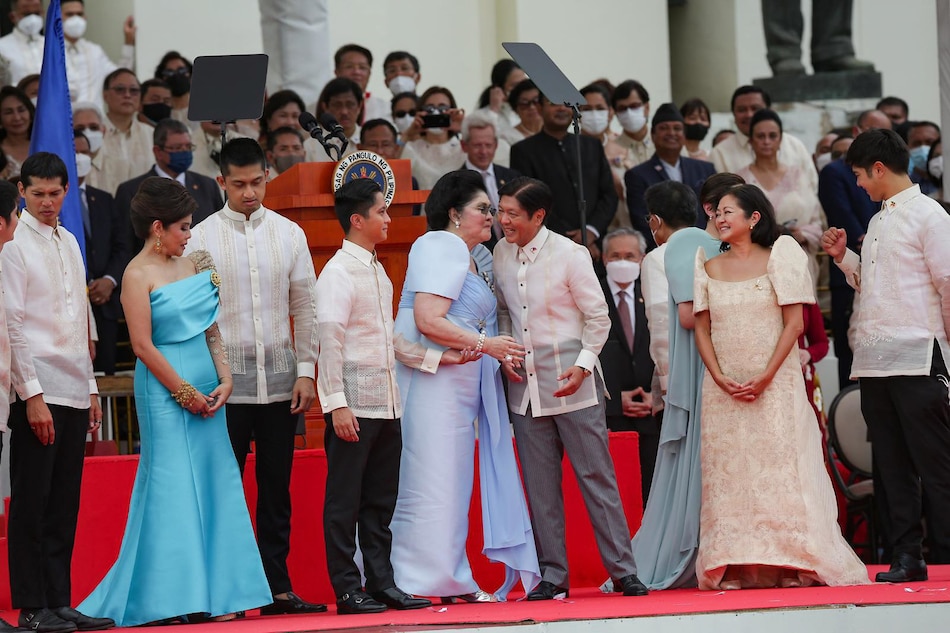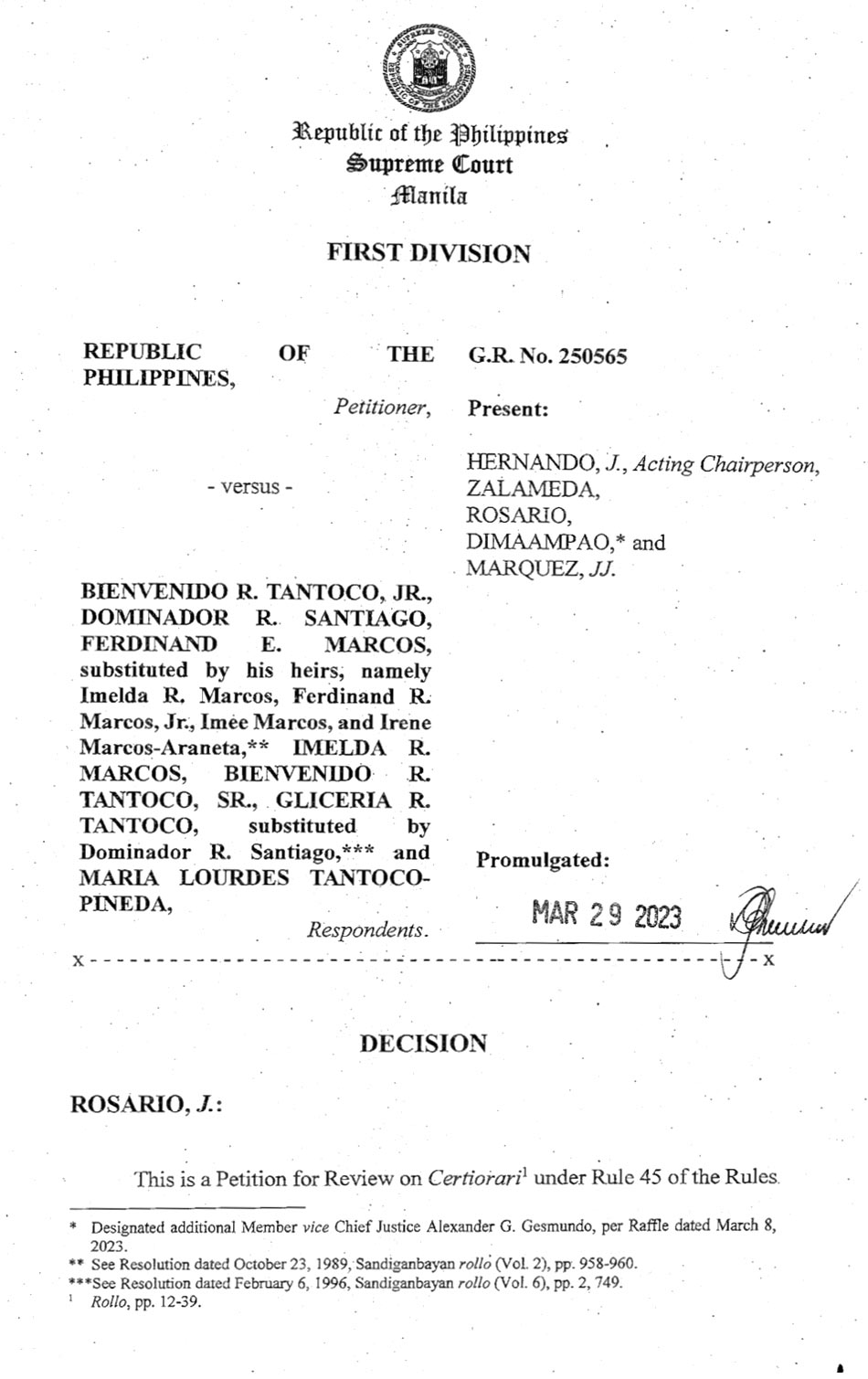Supreme Court affirms junking of ill-gotten wealth case vs Marcos, Imelda, cronies | ABS-CBN
ADVERTISEMENT

Welcome, Kapamilya! We use cookies to improve your browsing experience. Continuing to use this site means you agree to our use of cookies. Tell me more!
Supreme Court affirms junking of ill-gotten wealth case vs Marcos, Imelda, cronies
Supreme Court affirms junking of ill-gotten wealth case vs Marcos, Imelda, cronies
Mike Navallo,
ABS-CBN News
Published Jul 19, 2023 07:02 PM PHT
MANILA — The Supreme Court has affirmed the Sandiganbayan’s ruling junking an ill-gotten wealth case against the late former President Ferdinand Marcos, his wife Imelda and some cronies.
MANILA — The Supreme Court has affirmed the Sandiganbayan’s ruling junking an ill-gotten wealth case against the late former President Ferdinand Marcos, his wife Imelda and some cronies.
The case is a forfeiture case which sought to recover real and personal properties and damages amounting to P1.05 billion pesos from the Marcoses and their fellow respondents.
The case is a forfeiture case which sought to recover real and personal properties and damages amounting to P1.05 billion pesos from the Marcoses and their fellow respondents.
Marcos was accused of having unlawfully withdrawn funds from the National Treasury, the Central Bank, and other financial institutions, and transferring these funds to certain individuals who allegedly acted as dummies for their businesses and in acquiring properties on their behalf.
Marcos was accused of having unlawfully withdrawn funds from the National Treasury, the Central Bank, and other financial institutions, and transferring these funds to certain individuals who allegedly acted as dummies for their businesses and in acquiring properties on their behalf.
These properties included expensive works of arts, clothes, jewelry and billions worth of real estate including New York properties.
These properties included expensive works of arts, clothes, jewelry and billions worth of real estate including New York properties.
ADVERTISEMENT
Named as co-respondents with the Marcoses were: Bienvenido Tantoco, Jr., Bienvenido Tantoco, Sr., Gliceria Tantoco, Maria Lourdes Tantoco-Pineda and Dominador Santiago.
Named as co-respondents with the Marcoses were: Bienvenido Tantoco, Jr., Bienvenido Tantoco, Sr., Gliceria Tantoco, Maria Lourdes Tantoco-Pineda and Dominador Santiago.
They were accused of profiting from reduced taxes in operating duty-free shops and of acting as dummies, nominees or agents of the Marcoses in corporations such as Rustan International Marketing, Eagle Mining Corporation, Rustan Pulp and Paper Factory.
They were accused of profiting from reduced taxes in operating duty-free shops and of acting as dummies, nominees or agents of the Marcoses in corporations such as Rustan International Marketing, Eagle Mining Corporation, Rustan Pulp and Paper Factory.
Marcos, who died in 1989, was substituted by his heirs Imelda and their 3 children, while Gliceria Tantoco was substituted by Santiago.
Marcos, who died in 1989, was substituted by his heirs Imelda and their 3 children, while Gliceria Tantoco was substituted by Santiago.
The case, which was filed by the Presidential Commission on Good Government in 1987, was dismissed by the Sandiganbayan on September 25, 2019 and a motion for reconsideration was similarly junked on November 20, 2019 due to insufficiency of evidence.
The case, which was filed by the Presidential Commission on Good Government in 1987, was dismissed by the Sandiganbayan on September 25, 2019 and a motion for reconsideration was similarly junked on November 20, 2019 due to insufficiency of evidence.
In affirming the dismissal, the Supreme Court First Division said the Sandiganbayan “committed no reversible error.”
In affirming the dismissal, the Supreme Court First Division said the Sandiganbayan “committed no reversible error.”
ADVERTISEMENT
“While it may be true that the petitioner had submitted numerous pieces of evidence, many were excluded because they were not disclosed during the discovery process and others were excluded for violating the Best Evidence Rule. After all was said and done, only 11 exhibits and four testimonies were admitted,” said the decision penned by Associate Justice Ricardo Rosario.
“While it may be true that the petitioner had submitted numerous pieces of evidence, many were excluded because they were not disclosed during the discovery process and others were excluded for violating the Best Evidence Rule. After all was said and done, only 11 exhibits and four testimonies were admitted,” said the decision penned by Associate Justice Ricardo Rosario.
Justices Ramon Paul Hernando, Rodil Zalameda, Japar Dimaampao and Jose Midas Marquez concurred in the ruling.
Justices Ramon Paul Hernando, Rodil Zalameda, Japar Dimaampao and Jose Midas Marquez concurred in the ruling.
Discovery is the process by which parties can gain access to facts which could directly or indirectly support their claims and defenses.
Discovery is the process by which parties can gain access to facts which could directly or indirectly support their claims and defenses.
It could come in the form of depositions, written interrogatories, request for admissions, request for production or inspection of documents or things, and physical and mental examination of persons.
It could come in the form of depositions, written interrogatories, request for admissions, request for production or inspection of documents or things, and physical and mental examination of persons.
The high court faulted petitioner Republic of the Philippines for presenting documentary evidence that it did not produce during discovery proceedings despite declaring that it had no other documents to disclose, called this out as “intentional concealment of evidence.”
The high court faulted petitioner Republic of the Philippines for presenting documentary evidence that it did not produce during discovery proceedings despite declaring that it had no other documents to disclose, called this out as “intentional concealment of evidence.”
ADVERTISEMENT
Aside from concealment, SC cited violation of the Best Evidence Rule, a rule in evidence which requires the presentation of the original document, because the other documents were “either photocopies and/or were not properly authenticated.”
Aside from concealment, SC cited violation of the Best Evidence Rule, a rule in evidence which requires the presentation of the original document, because the other documents were “either photocopies and/or were not properly authenticated.”
The remaining evidence which the anti-graft court admitted were “either insufficient to prove the allegations of the Expanded Complaint, or were unrelated to the facts sought to be proved by petitioner.”
The remaining evidence which the anti-graft court admitted were “either insufficient to prove the allegations of the Expanded Complaint, or were unrelated to the facts sought to be proved by petitioner.”
The 11 pieces of evidence included letters, a deed of assignment and promissory notes, which, for the high court, are not proof of illegal acts.
The 11 pieces of evidence included letters, a deed of assignment and promissory notes, which, for the high court, are not proof of illegal acts.
The 4 witnesses — 2 from PCGG, 1 handwriting expert from the National Bureau of Investigation and 1 officer of a bank — were not found to be relevant to prove the ill-gotten wealth claim.
The 4 witnesses — 2 from PCGG, 1 handwriting expert from the National Bureau of Investigation and 1 officer of a bank — were not found to be relevant to prove the ill-gotten wealth claim.
“In order to consider petitioner’s evidence as sufficient to prove the allegations of its Expanded Complaint, the Court has to perform many leaps of logic, engage in presumptions, and create inferences based on other inferences in order to bridge the gaps in the evidence adduced. In the face of such gaps, petitioner’s allegations in its Expanded Complaint are reduced to mere speculations, insinuations and conjectures,” the court said.
“In order to consider petitioner’s evidence as sufficient to prove the allegations of its Expanded Complaint, the Court has to perform many leaps of logic, engage in presumptions, and create inferences based on other inferences in order to bridge the gaps in the evidence adduced. In the face of such gaps, petitioner’s allegations in its Expanded Complaint are reduced to mere speculations, insinuations and conjectures,” the court said.
ADVERTISEMENT
“Thus, while it is truly disappointing that nothing has come of this case despite the lapse of 36 years spent in litigation, the Court agrees with the Sandiganbayan that petitioner’s evidence is insufficient to support the allegations of its Expanded Complaint by a preponderance of evidence. Accordingly, the Sandiganbayan was correct in dismissing the Expanded Complaint for Reconveyance, Accounting, Restitution and Damages against all the Respondents,” it added.
“Thus, while it is truly disappointing that nothing has come of this case despite the lapse of 36 years spent in litigation, the Court agrees with the Sandiganbayan that petitioner’s evidence is insufficient to support the allegations of its Expanded Complaint by a preponderance of evidence. Accordingly, the Sandiganbayan was correct in dismissing the Expanded Complaint for Reconveyance, Accounting, Restitution and Damages against all the Respondents,” it added.
The dismissal is the latest in a string of ill-gotten wealth cases junked at the high court due to lack of evidence.
The dismissal is the latest in a string of ill-gotten wealth cases junked at the high court due to lack of evidence.
It involves one of the earliest cases filed in court against the Marcoses shortly after they were removed from power in the 1986 EDSA People Power Revolution.
It involves one of the earliest cases filed in court against the Marcoses shortly after they were removed from power in the 1986 EDSA People Power Revolution.
RELATED VIDEO
Read More:
Sandiganbayan
Supreme Court
ill-gotten wealth
Ferdinand Marcos Sr.
Imelda Marcos
Marcos cronies
ADVERTISEMENT
ADVERTISEMENT




